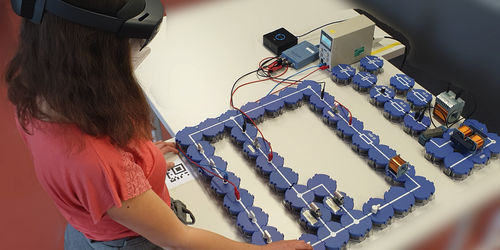Improved Problem Solving in Mixed Reality
Mixed reality—a hybrid of augmented and virtual reality—is of great interest for science educators because it offers fresh approaches to teaching and learning. But the benefits of using this technology to support students in lab-based activities have been largely unexplored. Now, Dörte Sonntag and Oliver Bodensiek at the Technical University of Braunschweig, Germany, demonstrate such a benefit by showing that mixed reality can increase success in experiment-related problem solving [1].
The researchers built an electrical circuit that contained a resistor, an inductor, capacitors, and a pair of lamps. They selected a problem-solving task that was divided into two parts: gaining an understanding of how the circuit works and altering the circuit to maximize the time lapse between one lamp going dark and the other lamp lighting up. This task was given to 45 university students, who were classified as either a novice or an expert on the basis of their level of relevant prior knowledge. Some students wore a mixed-reality headset that superimposed helpful virtual information—such as a visualization of the electric current—on the circuit. During the task, eye-tracking data were collected from all participants.
Sonntag and Bodensiek uncovered that the use of the headset greatly improved the problem-solving performance of both the novices and the experts. Moreover, the eye-tracking data showed that the technology increased the tendency for students—notably the novices—to take a balanced and global view of the circuit rather than focusing in on just a few elements, a factor the researchers linked to task success. The team thinks that mixed reality could be useful in other contexts, particularly those involving experiment-related learning.
–Ryan Wilkinson
Ryan Wilkinson is a Corresponding Editor for Physics Magazine based in Durham, UK.
References
- D. Sonntag and O. Bodensiek, “How mixed reality shifts visual attention and success in experimental problem solving,” Phys. Rev. Phys. Educ. Res. 18, 023101 (2022).




